Mathew Snyder's Blog: Mathew Snyder's Blog, page 3
August 19, 2014
Book Review: The Last Bayonet by Steven Hildreth, Jr.
In his debut novel The First Bayonet, Steven Hildreth, Jr. tackles kinetic action head on. It’s an urgently paced action thriller that never lets up, sometimes to its detriment as a rugged, sassy read.
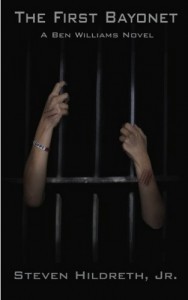 Hildreth is an Army Ranger veteran who deployed to Iraq, and it shows. The novel’s rich with military hardware details down to the millimeter. Dialogue dives in to spec ops lingo and headset protocols. The attention to details gives the action heft and should please aficionados.
Hildreth is an Army Ranger veteran who deployed to Iraq, and it shows. The novel’s rich with military hardware details down to the millimeter. Dialogue dives in to spec ops lingo and headset protocols. The attention to details gives the action heft and should please aficionados.
Central character Ben Williams is a retired special operations machine of a man who has turned to clandestine mercenary efforts. He’s hired to rescue Zaina, a fiery Egyptian intellectual and agitator, from an Egyptian prison and exfiltrate her from Mubarak’s oppressive state.
The novel’s set in 2006, well before recent tumultuous events in Egypt, which Hildreth leans on for whiffs of discontent and heavy-handed mukhabarat (secret police) activities. It is a tense, violent, and tough-as-nails book. Hildreth propels his hero from one impossible mission to another, and that hero shoots, punches, races, and chokes his way through each one, collecting an incredible body count along the way.
Williams is something of an intellectual himself, but unapologetic about his “direct action” approach. He doesn’t quite earn the warrior-poet mantle, but he’s no blunt instrument.
The book touches too briefly on much needed softer scenes as Williams and Zaina discuss politics and philosophy, cleverly bantering with one another through thoughtful references and a taste for cigarettes. Through Zaina, Williams almost reveals himself. But, readers are left with too much perfect action and too little insight into what makes Williams tick.
But, hard action waits for no man, especially not Colonel Agha. He’s the counterintelligence mastermind who pursues Williams throughout the novel, coolly directing his torture at particularly tough point of the book. Hildreth constructs a suitable villain for his man of action, and Agha’s progression from respectable spy-hunter to rage-blinded avenger is the best character writing in the novel.
When the dust settles and smoke clears, Hildreth accomplishes what he set out to do. It’s a hard-edged page turner that raises no questions or doubts about its too-accomplished hero. The result is a work this reader respects but wants to see a crack in that hero’s armor and a pause on that body count.
The First Bayonet by Steven Hildreth, Jr.: ★★★
The post Book Review: The Last Bayonet by Steven Hildreth, Jr. appeared first on Mathew Snyder's Blog.
June 29, 2014
Book Review: Hekura by Nate Granzow
In Hekura, author Nate Granzow has created a commentary on adventure fiction with a long tradition of rollicking paperbacks and horror-tinged thrillers. Here is homage to Crichton and Cussler with a new generation’s twist on action hero, beaten to a pulp.
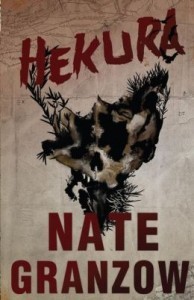 Hekura is a tale of science and corporate greed gone wrong, all in a soulless pharmaceutical company’s quest to capture rare Amazon plants to cure cancer. The titular creatures are nature’s revenge for its overreach. Deep in the Amazon jungle, researchers have transformed into brutish creatures who attack viciously at night like modern-day morlocks.
Hekura is a tale of science and corporate greed gone wrong, all in a soulless pharmaceutical company’s quest to capture rare Amazon plants to cure cancer. The titular creatures are nature’s revenge for its overreach. Deep in the Amazon jungle, researchers have transformed into brutish creatures who attack viciously at night like modern-day morlocks.
At the center of this mess is Austin Stewart. He’s a gun-running, drug running English flyboy who spouts English cliches and carries a distinctive Webley revolver. He smokes, drinks, swears, and turns on the charm for ladies. Granzow’s best character work is driving this stereotypical adventure story figure into a sympathetic sort who, through action, closes the tale with something to say about the genre and its importance beyond titillation.
Granzow paces chapters in staccato succession with tight, tense action interspersed with playful interaction, like Austin Stewart wooing divorcée Olivia, a smart scientist who seeks a fresh start. It makes for a grabbing, swift read and keeps interest.
The book is more than a monster mash in the jungle with its cast of troublesome characters, including a power-mad executive, her deadly mercenary contractor, a sadistic drug lord, and a sketchy group member who’s sabotaging the affair. Granzow puts the bad actors into a bestial blender and keeps the story moving.
The book stumbles at times with repetitive prose patterns that kept me recognizing the writer over the immersive action. It’s hardly an egregious flaw for the otherwise entertaining romp, but surfaces enough to itch.
The book regains its step with a satisfying string of closing surprises, including a fun cameo for any reader familiar with Granzow’s other books. And in those surprises, Granzow shares his vision for adventure — episodes of luck and daring in the face of indifference and injustice.
Hekura by Nate Granzow: ★★★★
The post Book Review: Hekura by Nate Granzow appeared first on Mathew Snyder's Blog.
June 9, 2014
Book Review: Resurrection: A Zombie Novel by Michael Totten
Like popular zombie comic and show The Walking Dead, Michael Totten’s Resurrection: A Zombie Novel is a character-driven suspense drama set amid a disease-ridden apocalypse.
 A handful of survivors gather together in frenetic events as the entire world has collapsed to a viral plague that turns humans into wild-eyed, aggressive cannibals. These are zombies closer to popular World War Z than George Romero, and Totten uses that to heighten the realistic effect of this apocalypse escapism.
A handful of survivors gather together in frenetic events as the entire world has collapsed to a viral plague that turns humans into wild-eyed, aggressive cannibals. These are zombies closer to popular World War Z than George Romero, and Totten uses that to heighten the realistic effect of this apocalypse escapism.
Totten jumps perspective among these characters, like Hughes, the herd-hearted protector and Kyle, the manipulative do-gooder, or Parker the self-centered alpha. These three struggle with leadership and outside tensions.
But, Annie is the novel’s pivot, as she carries a secret about the plague that will change everything for these survivors. Her secret is the crux of the book, and it’s a clever and interesting take that makes the book worth more than plain zombie “porn.”
As perspectives shift among these characters, the reader gets inside their heads and watches them change. The characters hope. They connive. They ache. They face hard truths about themselves and sometimes plot terrible plans for others.
The flaw in this approach is the sudden shifts without cue. Many shifts occur naturally with a break, others simply follow in paragraphs. It’s not hard to follow, but jars some, feeling a bit like the book needed a little more polish.
Wonderfully, the book improves considerably as pages turn. The zombie menace is real enough, but Totten doesn’t reveal their violent presence for many frustrating pages as the characters pace and argue.
But, then the zombies arrive again and again, and they’re dreadfully real. Totten sets the book in the Pacific Northwest, an area he knows well. Well enough to make a couple key scenes terrifying. Parker’s race to a boat in darkness and rain is a fantastic passage that nudges the book from tense character drama to real horror work.
Resurrection: A Zombie Novel by Michael Totten: ★★★★
The post Book Review: Resurrection: A Zombie Novel by Michael Totten appeared first on Mathew Snyder's Blog.
Book Review: A Dance With Dragons by George R. R. Martin
George R. R. Martin’s A Dance with Dragons manages to do what its less exciting twin, A Feast for Crows, couldn’t — reignite my love for the A Song of Ice and Fire series.
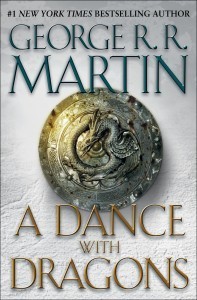 Events are more exciting than those of A Feast of Crows, and Martin drops more than a few page-turning cliffhangers throughout the book as he builds the grand narrative back up to another climactic peak. But, it’s a ponderous build-up at times, with disappointingly empty chapters and side-plots and supporting characters that seem to veer nowhere.
Events are more exciting than those of A Feast of Crows, and Martin drops more than a few page-turning cliffhangers throughout the book as he builds the grand narrative back up to another climactic peak. But, it’s a ponderous build-up at times, with disappointingly empty chapters and side-plots and supporting characters that seem to veer nowhere.
The book has a better pedigree than its predecessor. It’s filled with Martin’s best and most beloved characters in Tyrion Lannister, Jon Snow, Arya Stark, and Daenerys Targaryen. Martin throws into that mix some familiar faces like Theon “Reek” Greyjoy, who’s misery may top all of Westeros, which is saying much. And, one of my favorites, Davos Seaworth, appears early only to disappear for the remainder of the book in a puzzling absence.
For most of these favorites, things happen. Jon Snow deals with the hard (and sharp!) realities of being a leader of the Night’s Watch. Arya earns her mysterious stripes. Tyrion travels vast distances and sees many thing. But, Daenerys — ah, Daenerys is the trouble. Really, it’s her book and her transformation. But, like Cersei Lannister’s chapters in A Feast for Crows, her chapters plod on, one after another of off-stage events as she struggles to be queen. Her transformation is glorious, but getting there is a slog.
Then there are the new bloods — perspective characters like Oberyn Martell, Victarion Greyjoy, and Jon Connington. Martin seems to be playing with these new voices and events. His success wavers. Quentyn Martell feels superfluous, even irrelevant. Victarion more so, though he seems to have something major in store for Daenerys.
Given the death and destruction Martin inflicts on his characters, especially to the Stark family, there must be room for new voices like these. But, several thousand pages in, is Martin’s exploring a vast, wondrously dangerous playground or weaving one of the grandest fantasy narratives ever written? That question keeps me interested, but a little disappointed when these detours end abruptly. They drive home, painfully, his themes about ruthlessness and ambition, of fickle fates and violence, but test our trust that there is anything here worth rooting for, worth investing in.
Still, with A Dance with Dragons, there is a sense that Martin is that good — that all my fellow readers and I suffering for our favorite characters will see some pay off, some day, and we’ll earn a grand and satisfying ending.
A Dance With Dragons by George R. R. Martin: ★★★★
The post Book Review: A Dance With Dragons by George R. R. Martin appeared first on Mathew Snyder's Blog.
June 5, 2014
Book Review: Crossers by Philip Caputo
Crossers, by Philip Caputo, puts main character Gil Castle at the locus of 9/11 fallout and the drug war on the Arizona border. It’s a fascinating juxtaposition of new millennium violence, but leaves much unaddressed as the novel wanders amid a widower’s re-awakening and a crazed lady drug lord’s drive toward vengeance.
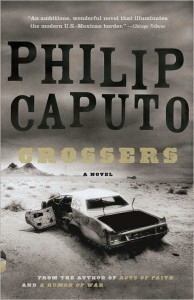 The novel begins with Castle consumed by loss of his wife in Twin Towers on 9/11. He’s wealthy, numb, and grieving to the point of self-destruction. Castle gives up his East Coast life and heads to Arizona to spend time with distant rancher cousins on the Arizona border.
The novel begins with Castle consumed by loss of his wife in Twin Towers on 9/11. He’s wealthy, numb, and grieving to the point of self-destruction. Castle gives up his East Coast life and heads to Arizona to spend time with distant rancher cousins on the Arizona border.
Castle is a captivating character who transforms through the novel. He’s believably noble, and on the mend. With him, the novel shines as he weaves from broken-hearted widower, to nascent romantic, and even protector of Mexican border crossers.
Elsewhere, the novel lacks. While the drug lord villains and their hangers on are despicable without being completely two-dimensional, they lack the movement of Castle and his inner workings.
Caputo intersperses the 21st modern day fiasco with interview accounts of Castle’s ancestors who get involved with border-crossing violence in early 20th century Mexico’s turbulent politics and blood feuds. While entertaining and larger than life, the episodes are thinly attached to the characters in the modern day.
Caputo seemed to be reaching for suspenseful connections and surprises to build tension between the Mexican drug lord family and Castle’s own extended clan. But, that suspense flags, in part due to Castle’s family being mostly ignorant of any feud.
What remains are the remarkably attractive guts of a novel that can’t quite deliver. To be sure, there’s solid writing, beautiful landscapes, and emotionally gripping characters and scenes. They feel partially assembled and unrealized, but at least they move and progress in ways that aren’t just tense gun-play and plots.
Crossers by Philip Caputo: ★ ★ ★
The post Book Review: Crossers by Philip Caputo appeared first on Mathew Snyder's Blog.
October 8, 2012
Book Review: The King’s Gold by Arturo Perez Reverte
This summer, I studied in Italy for two-weeks. On the weekend, a classmate and I visited the Cinque Terre by train. It’s a wondrous place that even great pictures can’t do justice:

The northernmost town of the Cinque Terre is Monterosso al Mare, a Mediterranean resort town. While we wandered the ristorantes and hotels, I searched for something to read on the long train ride back to Asolo. I checked one news shop, then another. In a last-ditch effort, I scanned a beach-front store with a small shelf of English language books. Tucked in the far corner I discovered The King’s Gold by Arturo Perez Reverte, the fourth novel in the Captain Alatriste series, which I adore.
So, I had a bizarrely continental experience reading an English translation of a Spanish adventure novel while travelling by train in Italy. It was a comfort on a lonely train ride back through the Italian countryside and industry towns.
The book reads rapidly. It’s a scoundrel’s adventure where Captain Alatriste works a secret mission for the king to intercept a treasure galleon. His youthful sidekick narrator, Inigo, grows up a bit on the adventure as he watches and learns from a cadre of criminals Alatriste enlists to complete the job. They fight, and some die, in the climactic assault on the beached ship. There’s the flamboyant bon vivant, the brute, the ultimately cowardly swindler. And yet, once again, Perez Reverte creates a fleeting sense of sympathy for the underside of Spanish society, doomed to ugly fates by the corrupt and powerful.
Nestled among the rogue’s heist are Inigo’s blindly brave love for Angélica de Alquézar, the beautiful and devious daughter of one of Alatriste’s key enemies. She teases and entraps Inigo, who senses her dangerous intentions, but dives in smitten anyway. In a key scene, he dares to face his killers alone at her behest, accepting it as a noble death. Of course, Alatriste intervenes and even Angélica is impressed by Inigo’s bravery.
These moments of poetic nobility by the commoners, thugs and hopeless romantics are the series in a nutshell. Perez Reverte keeps up the swashbuckling goodness and slighly melodramatic flair for a constantly amusing string of adventure yarns. The King’s Gold is a blunter force in the series, but entertaining nonetheless.
The King’s Gold by Arturo Perez Reverte: B
The post Book Review: The King’s Gold by Arturo Perez Reverte appeared first on Mathew Snyder's Blog.
October 7, 2012
Book Review: The Earthsea Trilogy by Ursula LeGuin
I’ve had worn, paperback copies of the Earthsea trilogy on my shelf for some time now. I picked them up used, happy to discover the trio of yellowing books. They seem even now emblematic of a fantasy trilogy much loved by some, overlooked by many.
So, I made them my summer read this year, snuck in between my jaunt to Europe, sneaking away with my wife for our anniversary, and tagging along with our family vacation to Tennessee.
In my effort to catch up here on my blog, I’ll review them in brief, collectively. It’s an endearing trilogy, presented simply but with deeper resonance, as few writers like LeGuin can do. 
The trilogy begins with A Wizard of Earthsea, the coming-of-age tale of Ged, a natural-born wizard who somewhat predictably suffers for his own pride. LeGuin lays the groundwork for her fabulous fables here. Ged learns along with the reader the nature of magic and the power of true names. In Earthsea, language is power, and wizards speak it by knowing the names of all things. Showing off, Ged delves deeper into Earthsea’s underworld and wrestles literally with a shadow thing, setting off his own wandering odyssey, first fleeing then hunting the thing.
LeGuin’s Earthsea is a wonderful setting. It’s a vast archipelago of isles, peopled with the simple and varied cultures that LeGuin’s so skilled at portraying in just a few trinkets or one or two characters. She has a knack for painting the fantastic in plain, poetic terms without seeming to stereotype. The magic is sometimes wondrous, sometimes too-plain, but the dragons are fabulous and frightening enough.
As Ged wanders the isles in his enchanted boat, he learns his lesson, and with it his power. His confrontation with the shadow thing is predictable, turning the novel into more of a fable than anything. Still, it’s a beautifully written fable, and LeGuin’s prose is pitch perfect.
A Wizard of Earthsea by Ursula LeGuin: A-
Book two in the trilogy is The Tombs of Atuan. LeGuin shifts perspective to a young priestess named Arha in Earthseas more severe cultures in the east. She’s taken from her family as a chosen one to tend a desolate conclave guarded by the cult. The conclave sits atop a labyrinthine tomb, locked by tradition in literal darkness.
The perspective shift is effective. Arha (the “eaten one”) begins to question her faith’s purpose from the inside while it’s clear to readers the cult is severe amid a despotic regime. LeGuin successfully explores Earthsea, and she’s able to tell a very different story here. The traditions are strange and limiting. The questions raised relevant to any reader who’s pondered the role of religion.
Of course, Ged shows up to cause trouble in seeking a lost treasure in the labyrinth. At first Arha’s captive, Ged befriends her and the two conspire against the traditions of the old gods.
Still, it’s Arha’s tale throughout, and her liberation’s bittersweet. While LeGuin pulls of a new tale in the same world, the telling’s dark, and more than a little forced. The effect is a much darker, but also colder tale.
The Tombs of Athuan by Ursula LeGuin: C+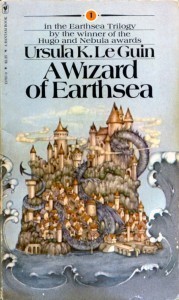
Finally, Ged’s journey comes full circle in The Farthest Shore. The narrative takes a familiar shape — LeGuin shifts perspective again to Lebannen, a prince from the north islands with a knack for speaking and bravery, but no wizardry. He brings to Ged, who now serves as the head wizard of the isles, rumors of magic failing across the lands.
So, the two set out alone to discover the hole in the world that’s destroying the power of magic. Once again, LeGuin lays on thick the fable qualities of the novels. They hop from one people to the next of devolved settlements struck dumb by the lack of helpful wizardry. And, with it, obsessions about immortal life.
Ged observes much, and bonds with Lebannen, who predicably — again too predictably — becomes the brave hero at Ged’s side. They drift with people who live entirely on the sea, skulk in cities laid low with greed, and ally with the eldest dragons to confront the expanding “nothing” destroying magic in wizards’ minds.
Despite that predictable quality, the bond between characters is genuine. And, Ged’s greatest moments suitably noble as he confronts a villainous wizard with understanding rather than power. LeGuin complete’s Ged’s saga well. Throughout, she makes the most of her superbly tidy prose and wonderful world.
The Farthest Shore by Ursula LeGuin: B+
The post Book Review: The Earthsea Trilogy by Ursula LeGuin appeared first on Mathew Snyder's Blog.
March 8, 2012
Book Review: Dark Star by Alan Furst
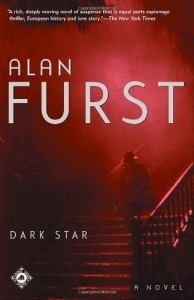
I have previously reviewed Alan Furst’s remarkable work in The Polish Officer, a book so enjoyable I happily returned to Furst’s European espionage thrills and passion in Dark Star.
It’s a dense and murky novel, a bit of an acquired taste like a fine Parisian coffee. In it, seasoned Soviet journalist André Szara evolves from reluctant party participant to full fledged spy master and ultimately romantic rogue. Like Furst’s other protagonists I’ve read, he’s an affable sort, a kind of European observer thrust into events he knows a far beyond his control.
Here, though, Furst’s gloves are off. Szara stumbles his way dejectedly amid NKVD (Stalin’s secret police, whose badges bear the titular star) machinations. His every move, he knows, is being watched. He faces death, quite directly it turns out, throughout his absurdly lucky run from a Belgian port to Prague, Moscow, Berlin, Paris, the Polish countryside, Vilnius, and Geneva. Szara’s self-preservation is a matter of instinct, of a clever Russian fully aware of the paradoxes of his country who scrambles at the merest whiff of doubt or worry. And, he becomes the inside observer to the worst slaughters in history.
Szara is a Polish Jew, and Furst trickles in Szara’s history with pogroms of eastern Europe. These, too, explain Szara’s instinct for survival, and hint at his tragic penchant for romance, having lost a young wife in the echoes of the Revolution. But it is the grind between Nazi Germany and Stalinist Russia, and the increasingly obvious plight of fellow Jews, that Furst makes his bleakest portraits of pre-war Europe. Szara experiences Kristallnacht first-hand in one tense scene. Meanwhile, he’s smitten by the Jewess of his espionage contact in Berlin, who reports on Germany’s war machine. Later, Szara moonlights with a mysterious French aristocrat to secure British certificates allowing Jews to flee to Palestine. So woven are these events into Szara’s instinctual European existence that Furst almost sneaks in any idea that Szara is any kind of hero for the Jewish plight. It’s master stroke, in my view, because it reveals the plain humanity of Jews in these locales, and the insane mentality that they do not belong.
Blended with this commentary is Szara’s role as NKVD handler at precisely the time Stalin purges the agency of its leaders. Furst haunts Szara with these distant events, leaving the journalist-spy alone, or with the odd comrade, to puzzle through disappearances and his own inexplicable survival. It is a byzantine dance Furst lets Szara — and readers — decipher. The effect is both that of thrilling urgency and dense puzzlement, even frustration. Who’s pulling these strings, and why? Will Szara ever know?
The answer is a question of moral courage for Szara, and he refuses to be one of many who asks “Za chto?” — “What for?” or “Why?” — with a gun in his back. He decides to leverage his borrowed time with payback and a little redemption worthy of his romantic soul.
The novel is filled with Furst’s trademark minor characters, European heroes and villains so elegantly conceived in mere paragraphs before their often tragic exits or quiet perseverance. Dark Star bursts with such lovable souls. And, of course, Furst reveals his other trademark — a vibrant setting pulsing with life, color and sensation. He’s at his best detailing Paris. Smoky cafés and night time rains, or sweltering arrondissements and fried potato smells. Berlin becomes a surreal landscape, and the Polish countryside almost beautiful amid the ruin of the blitzkrieg.
It’s the gamut of Furst’s best writing, but comes at a heavy price. The book is dense with characters and subtle plots, and the topic heavy and troubling. It’s a book that pulls you insistently, not happily. A rich, acquired taste that delivers not refreshment, but rather bittersweet heartache.
Dark Star by Alan Furst: A-
The post Book Review: Dark Star by Alan Furst appeared first on Mathew Snyder's Blog.
January 25, 2012
Book Review: The Hunger Games by Suzanne Collins
When I introduced my daughter to the dystopian perils of Katniss Everdeen a couple years ago, I was warned. The Hunger Games, by Suzanne Collins, was tough stuff and filled with terrible situations and violence that may be too much for young readers like her.
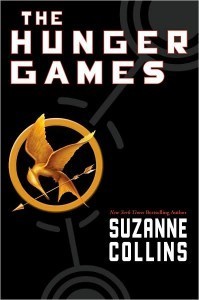
I have since spent my days hearing all about how fantastic and smart Katniss is, how my daughter likes anything to do with archery, and why I’m a terrible father for not yet pre-approving her attendance at the midnight debut of The Hunger Games movie this March.
I may have to relent.
On a whim, and only slightly pressured by the women in my house to read it before the movie arrives, I picked up Collins’ young adult sensation.
The book is the sometimes delicate, sometimes cold, and always cautious narration of Katniss Everdeen, a teenager living in the vague dystopian future of Appalachia. She survives for two reasons. She can hunt and scrounge in the forests (illegally, that is), and she lets almost no one close to her. And, she does it all for Prim, her precious and much less rugged younger sister.
Their Appalachia is District 12, the coal mining center of a centrally controlled totalitarian state referred to simply as the Capitol. The book reveals little about this awful dystopian state, as Collins prefers instead to let the perspectives of a shell-shocked young Katniss and her small community reveal the effects of oppression. The choice is odd, given the tradition of dystopian science fiction as political commentary. Collins has much to say here, though, particularly about young women, their obsessions with appearances, and also about how popular media – especially reality television — shapes our minds. Collins made exactly the right choices, I think, in presenting a largely faceless oppression. Yes, yes, of course the bad government is bad. But that’s not the point she’s after, and it makes The Hunger Games a sharper, more widely appealing book to young readers. Dare I suggest, a classic?
The Hunger Games are, of course, the centerpiece of it all. They are annual tribute by the 12 districts, and an obscene reminder by the Capitol of who’s in charge. Echoing the myth of Theseus and the minotaur, each district holds a lottery to send off one unlucky boy and girl to compete in these gladiatorial games, televised for all to watch. Katniss volunteers for the almost certain death in an effort to save her sister; it’s the first of many bold, heroic moves she makes.
They are nothing if not spectacle, these games. Katniss and her District 12 partner, Peeta, begin a feigned romance for the Capitol audiences, but it gives way to terror as the games begin, and Collins unveils her violent vision. She tortures all participants with gruesome injury and heartbreaking deaths. The death of one particular girl, whom Katniss befriends, is Collins wake-up call that this profoundly sad moment is no mere young adult page-turner.
Katniss excels in the game not really because she’s a bow hunter and survivor, but because she understands, even obsesses about how she appears. At every critical move, she considers and reconsiders not only what her young opponents must be thinking and planning, but what the watchers in the Capitol and her own sponsor must be thinking.
When the game announcer’s disembodied voice explains that the game rules have changed, she teams up with lovestruck Peeta, and quickly realizes that to survive and win, they must appear to be two lovers fighting to survive together. She knows the audience is wild for it, and Katniss learns to use this as a weapon of survival, and even as a weapon of political defiance. And survive she does at the cost of terrible injury and pretensions she can’t unravel.
Collins published her work as a trilogy, one of the hottest fiction series in many years. The hype has some merit. On its own terms, this first novel is a well done piece of fiction with a solid, if hard-edged, heroine that I’m proud to have my daughter admire. She can’t wait for me to read Catching Fire and Mockingjay.
For now, I’ll wait at least a little while to savor one of the finest young adult fiction books I’ve ever read.
The Hunger Games by Suzanne Collins: A+
The post Book Review: The Hunger Games by Suzanne Collins appeared first on Mathew Snyder's Blog.
January 9, 2012
Book Review: The Profession: A Thriller by Steven Pressfield

Steven Pressfield gathered acclaim for his novel Gates of Fire (among other works). There, he tells the militaristic tale of the 300 Spartans at Thermopylae. In The Profession: A Thriller, Pressfield fasts forwards to the near future. It’s still a mess of oil, sand, Islam, and mass media. His twist is the evolution of warfare to private armies – the good old mercenary.
The book centers on Gilbert “Gent” Gentilhomme, an accomplished ex-marine from cajun country who rides the literally bleeding edge of Force Insertion, a mercenary conglomerate that makes real world Black Water look like a lemonade stand. Gent is the best of the best, a stand out who glides through terrifying combat action and ethnic strife. Gent narrates in the present tense, adding to the kinetic flair. Pressfield’s flashbacks work well as Gent reveals his history with one General Salter, his lifetime leader and mentor.
With Gent, we begin to side with Salter, an apparently principled soul who defies bureaucrats in Washington to do the right thing in Eastern Africa. Pressfield’s heart-wrenching details give the novel punch, setting up up a tense, engrossing first half of the novel. Here, he creates plausible situations, tense action, and sympathetic reactions.
Less punchy is Gent’s relationship with his estranged wife, A.D. She’s a tenacious reporter, a cross between Christiane Amanpour and Lara Logan (complete with South African background, a la Logan). It’s clear Gent’s still smitten, but she’s after her next big story. What’s much less clear is why she leaves Gent in the lurch at a crucial point. It’s the single biggest head-scratcher in the novel, and comes at an absolutely critical point in the story.
From events in eastern Africa, the novel builds skillfully to an incredible, implausible climax. The larger-than-life Gen. Salter, thrusts himself and his mercenary super army into the role of American Caesar. It puts Gent into a frantic realization he’s propped up the elite who will dismantle the United States Constitution and with it the republic. Gent comes to this realization too late, uncovering gruesome conspiracy inside the Beltway. He’s party to Salter’s rise to power, believing more in a near-mystical warrior poet ethic than any liberal values he once fought for.
The inevitable confrontation between soldiers gives lie to Gent’s penchant for superstition, visions of himself as an ancient warrior on an ancient battlefield. Somehow, amid the hyper-real setting, the visions aren’t bunk.
Throughout the novel, Pressfield tosses in amusing commentary as color for his near-future landscape. Digital media is ubiquitous, subsuming information brands with The New York Google Times, and a hint of Amazon store fronts. He imagines the macho life of future mercenary warriors, rich with enough details to please military fiction aficionados. And, despite a relatively tidy cast of characters manipulating complex oil markets and the fickle U.S. electorate, the future is a well-realized home for Gent.
If Pressfield’s biggest sin here is flying to close to the sun with a over-reaching plot, the story survives (Gent’s wife’s baffling turn is part and parcel of the big event). Gent’s perspective and the well-paced chapters are a pleasure, and I happily recommend the book. Pressfield can definitely do thrillers.
The Profession: A Thriller by Steven Pressfield: B+
The post Book Review: The Profession: A Thriller by Steven Pressfield appeared first on Mathew Snyder's Blog.
Mathew Snyder's Blog
- Mathew Snyder's profile
- 18 followers



